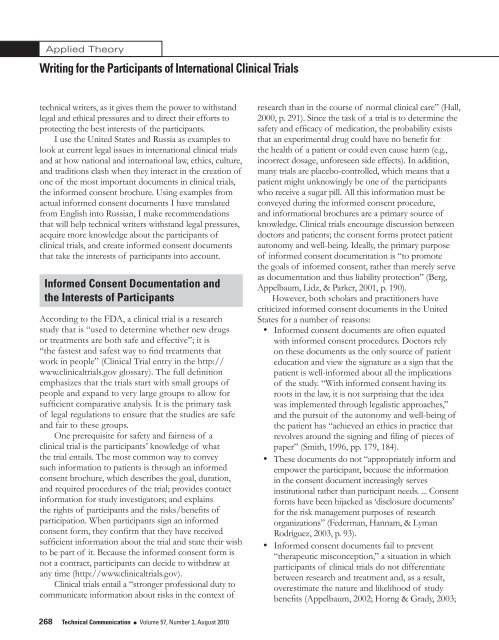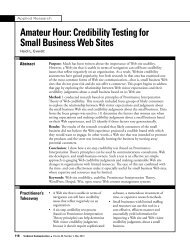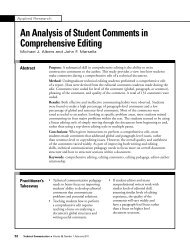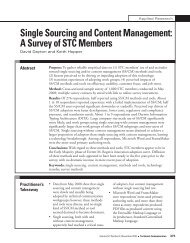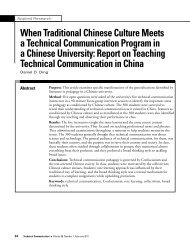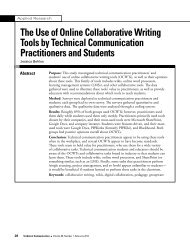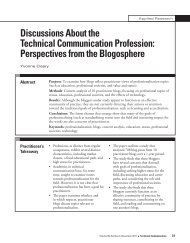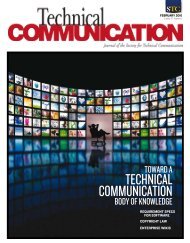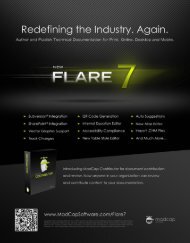CONTEXTS
Download: August 2010 - Technical Communication - Society for ...
Download: August 2010 - Technical Communication - Society for ...
- No tags were found...
You also want an ePaper? Increase the reach of your titles
YUMPU automatically turns print PDFs into web optimized ePapers that Google loves.
Applied TheoryWriting for the Participants of International Clinical Trialstechnical writers, as it gives them the power to withstandlegal and ethical pressures and to direct their efforts toprotecting the best interests of the participants.I use the United States and Russia as examples tolook at current legal issues in international clinical trialsand at how national and international law, ethics, culture,and traditions clash when they interact in the creation ofone of the most important documents in clinical trials,the informed consent brochure. Using examples fromactual informed consent documents I have translatedfrom English into Russian, I make recommendationsthat will help technical writers withstand legal pressures,acquire more knowledge about the participants ofclinical trials, and create informed consent documentsthat take the interests of participants into account.Informed Consent Documentation andthe Interests of ParticipantsAccording to the FDA, a clinical trial is a researchstudy that is “used to determine whether new drugsor treatments are both safe and effective”; it is“the fastest and safest way to find treatments thatwork in people” (Clinical Trial entry in the http://www.clinicaltrials.gov glossary). The full definitionemphasizes that the trials start with small groups ofpeople and expand to very large groups to allow forsufficient comparative analysis. It is the primary taskof legal regulations to ensure that the studies are safeand fair to these groups.One prerequisite for safety and fairness of aclinical trial is the participants’ knowledge of whatthe trial entails. The most common way to conveysuch information to patients is through an informedconsent brochure, which describes the goal, duration,and required procedures of the trial; provides contactinformation for study investigators; and explainsthe rights of participants and the risks/benefits ofparticipation. When participants sign an informedconsent form, they confirm that they have receivedsufficient information about the trial and state their wishto be part of it. Because the informed consent form isnot a contract, participants can decide to withdraw atany time (http://www.clinicaltrials.gov).Clinical trials entail a “stronger professional duty tocommunicate information about risks in the context ofresearch than in the course of normal clinical care” (Hall,2000, p. 291). Since the task of a trial is to determine thesafety and efficacy of medication, the probability existsthat an experimental drug could have no benefit forthe health of a patient or could even cause harm (e.g.,incorrect dosage, unforeseen side effects). In addition,many trials are placebo-controlled, which means that apatient might unknowingly be one of the participantswho receive a sugar pill. All this information must beconveyed during the informed consent procedure,and informational brochures are a primary source ofknowledge. Clinical trials encourage discussion betweendoctors and patients; the consent forms protect patientautonomy and well-being. Ideally, the primary purposeof informed consent documentation is “to promotethe goals of informed consent, rather than merely serveas documentation and thus liability protection” (Berg,Appelbaum, Lidz, & Parker, 2001, p. 190).However, both scholars and practitioners havecriticized informed consent documents in the UnitedStates for a number of reasons:• Informed consent documents are often equatedwith informed consent procedures. Doctors relyon these documents as the only source of patienteducation and view the signature as a sign that thepatient is well-informed about all the implicationsof the study. “With informed consent having itsroots in the law, it is not surprising that the ideawas implemented through legalistic approaches,”and the pursuit of the autonomy and well-being ofthe patient has “achieved an ethics in practice thatrevolves around the signing and filing of pieces ofpaper” (Smith, 1996, pp. 179, 184).• These documents do not “appropriately inform andempower the participant, because the informationin the consent document increasingly servesinstitutional rather than participant needs. ... Consentforms have been hijacked as ‘disclosure documents’for the risk management purposes of researchorganizations” (Federman, Hannam, & LymanRodriguez, 2003, p. 93).• Informed consent documents fail to prevent“therapeutic misconception,” a situation in whichparticipants of clinical trials do not differentiatebetween research and treatment and, as a result,overestimate the nature and likelihood of studybenefits (Appelbaum, 2002; Horng & Grady, 2003;268 Technical Communication l Volume 57, Number 3, August 2010


